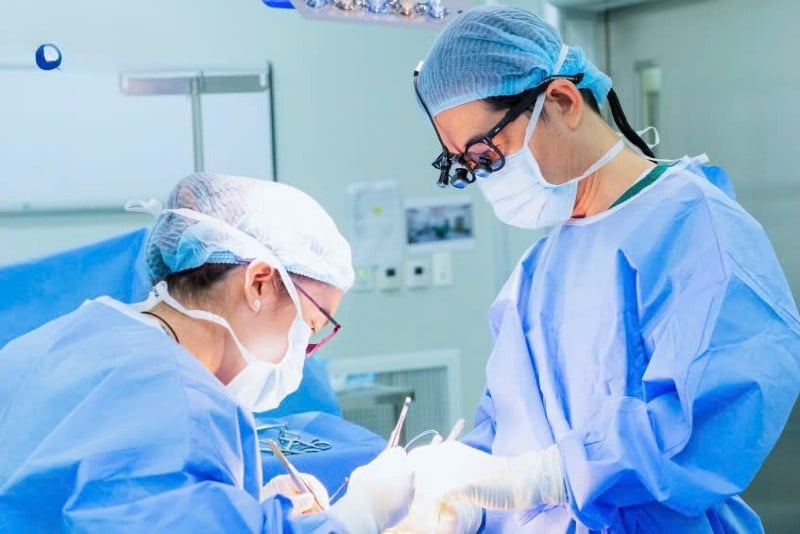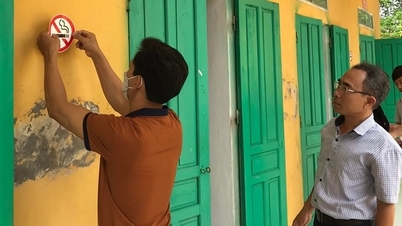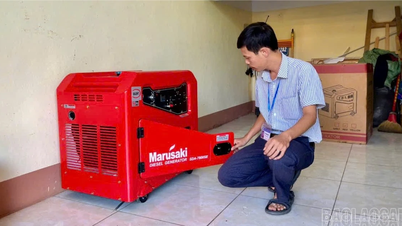Rare thoracic outlet syndrome is underdiagnosed
Ms. Hien (42 years old, Ho Chi Minh City) has had numbness in her right arm for many years and was diagnosed with cervical spondylosis. Despite taking prescription medication from many medical facilities, the condition did not improve but became more and more severe. Her right arm not only became numb, weak, and painful, but also began to atrophy, significantly reducing her mobility, affecting her daily activities.
 |
| Illustration photo. |
When she went to a private clinic for an ultrasound, the doctor discovered that her right brachial plexus was being compressed by the scalene muscle, a typical sign of Thoracic Outlet Syndrome (TOS). Ms. Hien was then transferred to the hospital for further intensive treatment.
Dr. Nguyen Anh Dung, Head of the Department of Thoracic and Vascular Surgery, Tam Anh General Hospital, Ho Chi Minh City, said that TOS is a rare syndrome, originating from congenital anatomical abnormalities.
In youth, the muscles are still soft so the compression is not yet obvious. However, over time, the muscles in the neck and shoulder become stiff and degenerate, revealing symptoms, especially in manual workers or those who have to move their shoulders repeatedly.
Anatomically, the thoracic outlet is the space from the supraclavicular fossa to the axilla, where blood vessels and nerves pass between the clavicle, upper ribs, and muscles of the neck and shoulder area. When these structures are compressed, the patient will experience symptoms such as pain, numbness, weakness of the shoulder and arm, tingling of the fingertips, muscle atrophy of the hand, and even loss of sensation or movement.
Because the symptoms are quite similar to common neurological and musculoskeletal diseases such as cervical spondylosis or carpal tunnel syndrome, many people are easily misdiagnosed, leading to long-term incorrect treatment. Ms. Hien's case is a typical example.
Thoracic outlet syndrome is divided into three types: neurogenic (nTOS, accounting for 95%), venous (vTOS - 3-5%) and arterial (aTOS, 1-2%). Of these, nTOS is the most common type, occurring when the brachial plexus - the network of nerves that control movement and sensation in the shoulder, arm, and hand - is compressed.
After being properly diagnosed, Ms. Hien was assigned to surgery to release the compressed area. The doctors made a 5cm skin incision above the clavicle, peeled the surrounding tissue and muscles to expose the subclavian vessels and nerves, then cut the anterior scalene muscle, the main cause of the compression. The surgery lasted about two hours and was a great success.
Just one day after surgery, Ms. Hien's hand numbness completely disappeared, she regained normal movement, and was instructed to do physical therapy to improve her hand function. After three days, she was discharged from the hospital and continued to have regular check-ups and exercises as prescribed.
Dr. Nguyen Anh Dung said that in addition to congenital causes, TOS syndrome can also be caused by factors such as prolonged bad posture (bowing head, drooping shoulders), shoulder and neck injuries, working in repetitive positions, frequently carrying heavy objects or obesity causing pressure on the muscular and vascular systems.
Occupational groups at high risk of the disease include athletes, musicians, hairdressers, office workers, assembly line workers, teachers... The disease usually appears between the ages of 20-50, with women accounting for a higher proportion due to body structure and occupational characteristics.
To prevent thoracic outlet syndrome, doctors recommend that people maintain good posture when sitting and working (keep your back straight, shoulders open, and head not bent for too long), take regular breaks to stretch, avoid carrying heavy loads on the shoulders, maintain a reasonable weight, and practice gentle exercises such as yoga, meditation, and deep breathing.
Early recognition of symptoms and proper specialist examination play an important role in effectively treating this syndrome, avoiding serious neurological and vascular complications and improving the patient's quality of life.
Prolonged hoarseness due to vocal cord fibroids
Having a hoarse voice and sore throat for many months, Ms. Th. (43 years old, teacher in Ho Chi Minh City) went to the doctor and was found to have vocal cord nodules on both sides, causing her voice to gradually decline, seriously affecting her quality of life and work.
As a high school teacher, Ms. Th. uses her voice continuously for 7-8 hours a day. For many years, she often suffered from sore throat, hoarseness, and sometimes loss of voice. At one point, the doctor diagnosed her with gastroesophageal reflux.
However, in the past two months, the hoarseness became more serious, accompanied by a sore throat, shortness of breath, difficulty in speaking clearly, and choking when talking. Worried because her voice was getting weaker and weaker and at times she almost lost her voice, she went to Tam Anh General Hospital in Ho Chi Minh City for a check-up.
Here, Master, Doctor, Specialist II Tran Thi Thuy Hang, Head of the Department of Otorhinolaryngology, Otorhinolaryngology Center, performed an ear, nose, and throat endoscopy for the patient. The results showed that the middle cleft of the nose secreted fluid, the nasopharynx had fluid retention, the throat was congested, both vocal cords were swollen, the arytenoid cartilage was congested, and there were granular lesions on both sides of the vocal cords, suspected of being vocal cord nodules.
The doctor diagnosed Ms. Th. with congestive pharyngitis - laryngitis, rhinitis and monitored vocal cord nodules. She was prescribed internal medicine and instructed to limit the use of her voice, not to speak loudly, not to strain when pronouncing, to gargle with saline, to drink plenty of water, and to avoid exposure to dust and chemicals.
However, due to the nature of her job as a classroom teacher, Ms. Th. still has to use her voice every day. After 1, 2 and 4 weeks of follow-up examinations, endoscopy results showed that the vocal cord nodules were not responding well to medical treatment and voice therapy.
This not only causes the voice to weaken more and more but also seriously reduces the patient's quality of life. The doctor decided to perform endoscopic laryngeal suspension surgery to remove the fibrous nodules on both vocal cords.
During surgery, the doctor uses a rigid endoscope combined with a laryngeal suspension system to clearly observe the entire vocal cord area on the screen.
The fibrous nodules on both sides of the vocal cords are then removed with specialized microsurgical instruments, while hemostasis is performed on the spot. The surgery is quick, only about 15 minutes, and does not require sutures. This method has the advantage of being minimally invasive, quick recovery, limiting fibrous scarring, helping to preserve maximum voice function.
After the surgery, Ms. Th.'s health stabilized and she was discharged from the hospital one day later. The doctor instructed her to absolutely limit speaking for the first three days, not to speak loudly, not to clear her throat, to avoid dust and smoke, to keep her throat moist and to drink plenty of water. A follow-up visit after a week showed that her vocal cords were healthy and her voice had clearly recovered. Two weeks after the surgery, the symptoms of hoarseness and sore throat had almost completely disappeared.
According to Dr. Hang, vocal cord fibroids or vocal cord nodules are a condition in which small fibrous tissues appear symmetrically in the middle of both sides of the vocal cords.
These nodules are often formed due to the vocal cords having to work too hard for a long time, causing the mucosa to be damaged and lose elasticity. Over time, the tissue proliferation leads to the formation of fibrous nodules. The disease is common in people who use their voices at high intensity such as singers, teachers, MCs, streamers, etc.
Some other factors also contribute to increasing the risk of vocal cord fibroids such as prolonged pharyngitis - laryngitis, laryngopharyngeal reflux, chronic gastroesophageal reflux...
Common symptoms include persistent hoarseness, weak voice, shortness of breath, difficulty speaking, and a feeling of something stuck or pain in the throat. If not treated promptly, the patient may experience complications such as acute laryngitis, vocal cord hemorrhage, and even difficulty breathing.
Treatment of vocal cord fibroids depends on the severity of the disease. In the early stages, doctors will prioritize medical treatment combined with changing voice habits. If the disease does not respond, doctors will prescribe surgery to remove the fibrous nodules to restore vocal function.
To prevent vocal cord fibroids, people, especially those who have to talk a lot, should limit speaking loudly, not speaking continuously for long periods of time, avoid speaking when tired or in noisy environments. Voice support devices such as microphones and speakers should be used to reduce pressure on the vocal cords. In addition, it is necessary to avoid alcohol, not smoke, maintain nasal and throat hygiene, wear masks when going out and working in polluted environments.
Maintain a healthy lifestyle, eat nutritious food, drink plenty of water, exercise regularly to increase resistance. In particular, it is necessary to thoroughly treat related diseases such as gastroesophageal reflux, pharyngitis, sinusitis... to protect respiratory health and maintain a healthy voice.
Childhood obesity is increasing alarmingly.
In Vietnam, the rate of overweight and obese children is increasing at an alarming rate, with the annual growth rate of obesity (BMI ≥ 30) reaching 9.8%. It is estimated that 1 in 2 children is overweight or obese, with boys at higher risk than girls.
The information was given at the scientific workshop "Multimodal treatment of obesity" recently held with the participation of many experts in the fields of endocrinology, pediatrics, and nutrition.
Experts emphasize that childhood obesity is not only increasing in Vietnam but is becoming a serious global health problem.
The World Health Organization (WHO) ranks childhood obesity as one of the biggest public health challenges of the 21st century. Children who are obese from an early age are at high risk of remaining obese as adults and of developing non-communicable diseases such as type 2 diabetes, cardiovascular disease, fatty liver, and mental disorders.
Associate Professor, Dr. Vu Huy Tru, a pediatrician, said that obese adolescents have a 2.6 times higher risk of prediabetes; up to 60% have sleep apnea syndrome. About 70% of children aged 5-17 who are overweight have at least one risk factor for cardiovascular disease in the future.
In addition to physical effects, obese children are also prone to psychological disorders due to body image disorders or discrimination. Therefore, obesity treatment cannot be simply weight loss but needs to be individualized, correctly identifying the cause, and then choosing the appropriate solution.
Associate Professor Tru said that obesity treatment requires the application of the “three-legged stool” principle including: a reasonable diet, regular physical exercise and medication (applicable to children 12 years of age and older). Doctors need to work closely with families to maintain long-term changes in children’s behavior and living habits.
Analyzing the causes of obesity in children, MSc. Vo Dinh Bao Van, Department of Endocrinology - Diabetes, said that obesity in children is not simply due to overeating and lack of exercise. The cause can come from genetic factors, endocrine disorders, side effects of drugs, psychological factors or sedentary living environment, eating excess energy.
Many studies have shown that if one parent is obese, the risk of their child being obese increases significantly. Children born into families with normal parents have an obesity rate of about 9%; if one of the two is obese, the rate increases to 41-50%; if both are obese, the child's risk is up to 66-80%.
“Intervention needs to start early, right from pregnancy. More importantly, changing behavior and living habits in the family is the key to sustainable prevention of obesity and chronic diseases in the future,” Dr. Van emphasized.
Dr. Phan Thi Thuy Dung, Department of Endocrinology - Diabetes, said that the treatment of obesity in children under 18 years old needs to be very careful because this is a group in the growth stage. Therefore, the goal is not to lose weight but to maintain a weight appropriate to the body's growth rate, through lifestyle changes.
Dr. Dung said that currently, new obesity treatment drugs are licensed for children 12 years of age and older. Among them, the GLP-1 RA agonist group has been proven to be highly effective and safe through international clinical trials, and is being used under control in some cases in Vietnam.
However, according to Dr. Lam Van Hoang, Head of the Department of Endocrinology - Diabetes, treating obesity in children is more difficult than in adults, due to its relation to behavior and psychology. "A shortcoming in current treatment regimens is that they do not pay due attention to the role of psychological counseling. The use of medication, if necessary, must also be cautious and closely monitored," he shared.
Experts agree that treating and preventing childhood obesity should be a top medical priority. The most important thing is to change the lifestyle of the whole family, build a healthy living environment, support children to exercise, eat properly and control their psychology. Early intervention not only helps children to be healthier now but also significantly reduces the risk of chronic diseases later.
Source: https://baodautu.vn/tin-moi-y-te-ngay-39-hoi-chung-loi-thoat-long-nguc-hiem-gap-dang-bi-bo-sot-trong-chan-doan-d377932.html




![[Photo] Prime Minister Pham Minh Chinh chaired a meeting of the Steering Committee on the arrangement of public service units under ministries, branches and localities.](https://vphoto.vietnam.vn/thumb/1200x675/vietnam/resource/IMAGE/2025/10/06/1759767137532_dsc-8743-jpg.webp)

![[Photo] Prime Minister Pham Minh Chinh chairs a meeting of the Government Standing Committee to remove obstacles for projects.](https://vphoto.vietnam.vn/thumb/1200x675/vietnam/resource/IMAGE/2025/10/06/1759768638313_dsc-9023-jpg.webp)

































































































Comment (0)